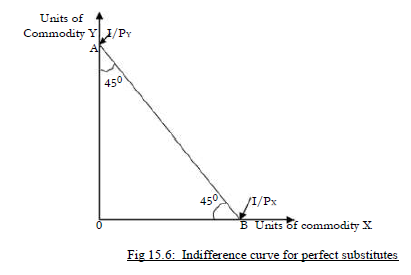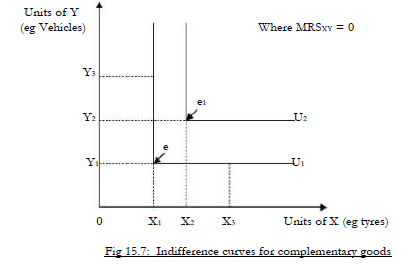1. The case of perfect substitutes:
For perfect substitutes the nature of the indifference curve is such that it?s a
straight line with a constant slope implying that the marginal rate of substitution is constant
i.e. MRS = 1. In this case, the goods being consumed are mutually exclusive in consumption
such that either of them can be exclusively consumed (without the other) while the
consumer derives the same level of satisfaction.

MRSxy = 1 implying that the quantity of Commodity Y the consumer would give up for additional
units of commodity X would be constant (the same), while deriving the same level of
satisfaction. eg. Petrol from Caltex and petrol from Total.
It?s possible for the consumer to spend all his income on either X or Y without any change in satisfaction;
at point A it?s I/Py and at B it?s I/Px i.e. at A it?s (I/Py) units of Y and at B it?s (I/Px) units of X without X and
Y respectively.
2. The case of complementary goods:
Complementary goods are those goods used together or jointly such that no satisfaction can be derived by
exclusively consuming either of them, that is, satisfaction can only be obtained by way of combination.
Examples of such goods include: Watch and Battery, vehicle and tyres, guns and bullets, film and camera, car
and petrol etc; such goods are related in such a way that an increase in price of one (e.g. vehicles) causes a
decrease in the quantity demanded of the other (e.g. tyres).
The indifference curves for complementary goods are L-shaped (right-angled) since marginal rate of
substitution is equal to zero, that is, marginal rate of substitution is equal to zero implying that there is no
possibility of substitution.

The consumer on indifference curve U1 is able to consume (combine) Y1 units of commodity Y and X1
units of commodity X at point e; any additional consumption of X from, say, X2 to X3 (while keeping the
consumption of Y constant) will NOT yield the consumer any higher satisfaction, that is, utility remains the
same. It also means that utility can only be increased by increasing the consumption of both commodities X
and Y as shown by the shift of the indifference curve upwards and to the right from U1 to U2; Again any
increase in the consumption of Y from say Y2 to Y3 (while maintaining the consumption of X constant) will
NOT in any way change the utility level of the consumer.
Wilfykil answered the question on
February 6, 2019 at 07:11